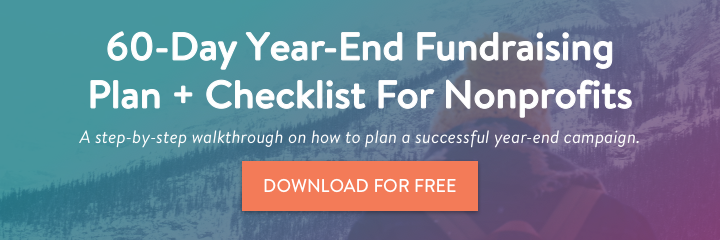Article first published November 2016, updated June 2019
We read the news, shop, and connect with friends online. We send and receive dozens (if not hundreds) of emails a day, and then respond to Facebook messages, Tweet, poke, chat, and create Instagram stories about our lives.
Some of us even communicate with our doctors and accountants through online portals.
You can’t deny that our lives online are irreversibly connected to our lives “offline”—which is why it doesn’t come as a surprise that we’re even connecting and donating to our favorite nonprofits and charities online.
In 2015, around 7% of all charitable donations were made online, and this figure is expected to grow in the coming years.
As our online and offline worlds continue to merge, it’s now more important than ever for nonprofits to better understand how to effectively drive online donations. Whether your nonprofit has overlooked online giving, is just getting started, or has been focusing on donations online for some time, Rob Wu, CEO and Co-founder of CauseVox shares 15 proven ways that your nonprofit can bring in more online donations.
1. Perfect your email marketing.
Email marketing for nonprofits helps send impactful email campaigns that deepen donor relationships and achieve fundraising goals. Nonprofits can use email marketing to recruit volunteers, re-engage lapsed donors, drive attendance to your next event, and, of course, fundraise.
Focus on email marketing best practices including:
- A strong, effective subject line
• Recognizable sender name (“From” name)
• Concise, personalized content
• A direct call to action
Aside from content, frequency also matters. While you may think that less is more, nonprofits receive fewer unsubscribes when they send 4 or more emails per month. You can figure out the ideal email frequency for your audience by testing your frequency to portions of your list. See if your engagement increases and the impact it has on your unsubscribes before you increase your frequency and always let your subscribers know the added value they’ll get from receiving more email from you.
Save the Children has a strong fundraising email campaign as seen in this email:

Check out this guide for more tips on email marketing for your nonprofit.
2. Leverage social media.
While social media platforms have begun to incorporate donation-specific features (think Facebook Donate button), nonprofits shouldn’t overlook the biggest power of social media: exposure.
Facebook, Twitter, Pinterest, and Instagram are all great ways to spread the word about your cause to current supporters. As people learn about your organization, you’ll be giving them the tools (and fuel) to share your cause with their own friends and family.
We’ve seen nonprofits and charities leverage the natural exposure that social media creates by:
- Using social sharing buttons on your website, emails, and content
- Asking your supporters to connect with your cause and to share your message with others
- Distributing shareable content across all platforms
For example, Neverthirst uses social sharing buttons on all of their website pages.

3. Leverage peer-to-peer fundraising.
Ask your most loyal supporters to raise money on behalf of your organization by becoming personal fundraisers for a peer-to-peer fundraising campaign.
Not only does this online crowdfunding technique help to increase your reach, but it’s also a way for you to engage those supporters that are looking for another way to get involved.
Peer to peer fundraising can be a great tool to maximize donations and reach a larger audience. If even a small portion of your constituents created their own peer-to-peer fundraiser and reached out to their families, friends, and community members, you’ll be able to reach your fundraising goals in no time.
Plus, the additional exposure may result in gaining more long-term donors for your organization.
Save the Frogs is using online peer-to-peer fundraising with CauseVox to fund a conversation project. Teams of fundraisers are helping to spread the word—and raise money—for this cause.
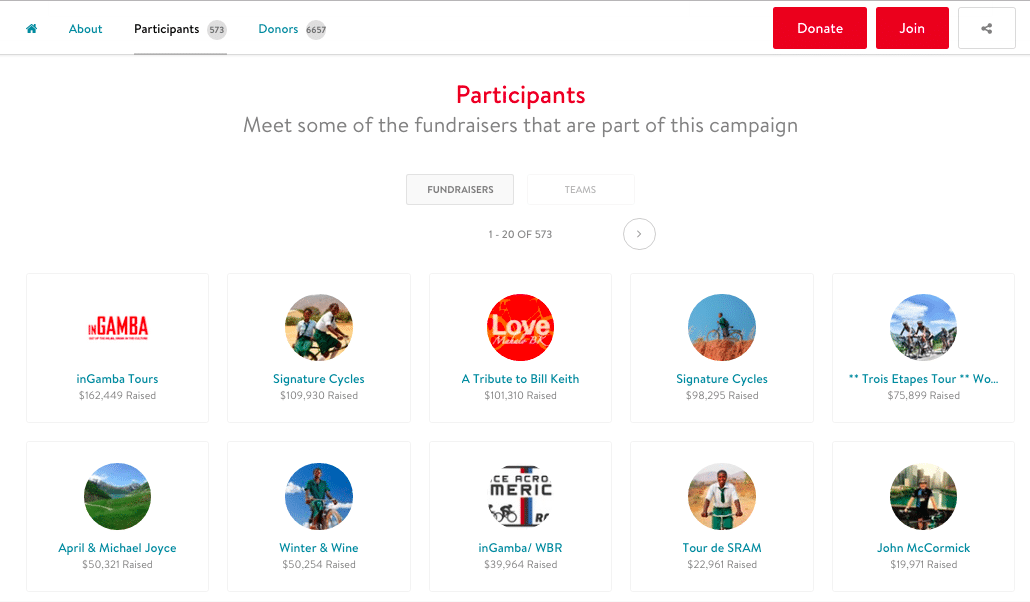
4. Remember website popups.
As we’ve helped power thousands of nonprofit’s online fundraising, we’ve found website popups to be a surprisingly effective way to capture a prospective donor’s name and email address. After all, if someone makes the effort to visit your website (and especially your donation page) chances are they’re looking to get involved.
Now may not be the right time for them to give a gift, but a follow-up email or other form of outreach could be the way to engage that person down the road.
Popups can be strategically placed depending on your preferences. To see a subtle, effective popup, check out the Human Rights Watch website.

5. Organize your donation page.
If online giving isn’t easy, people won’t donate to your organization. Make it easy to give by presenting a clean, organized donation page.
Check out these stellar donation pages by Girls Write Now and charity:water.
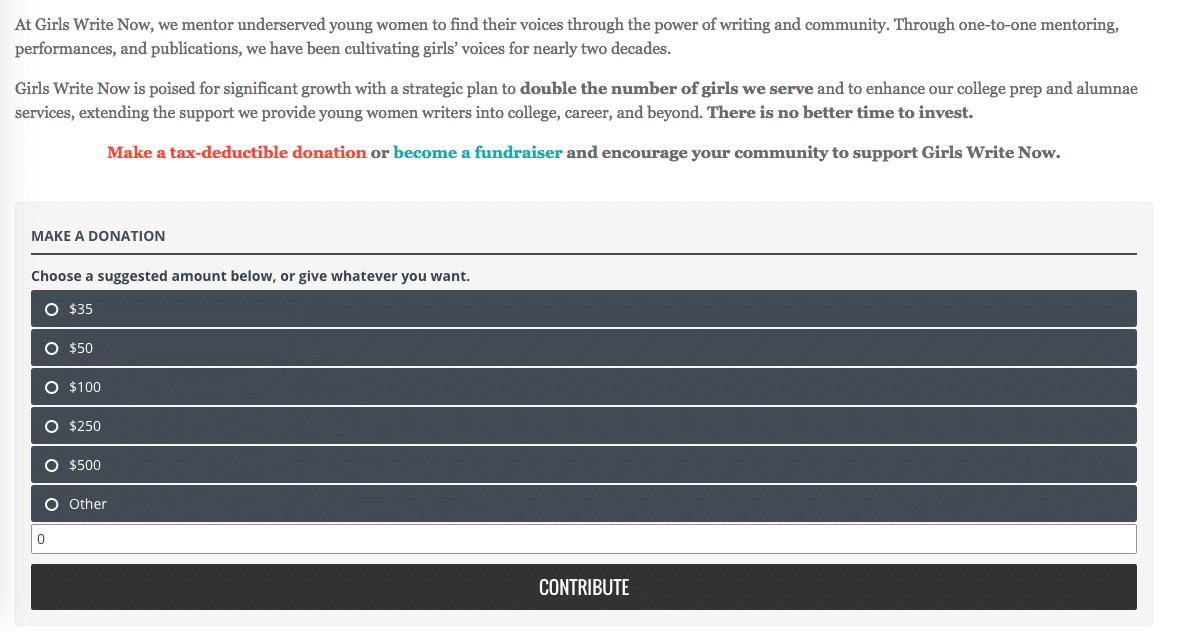
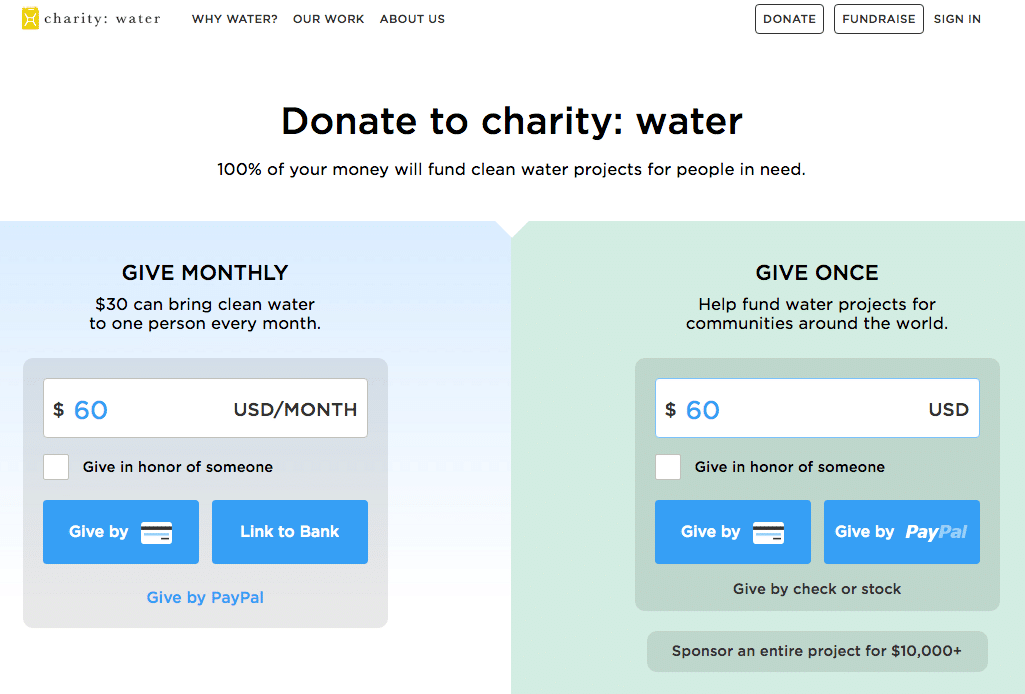
6. Optimize for mobile.
People are using their mobile devices to connect with your organization. Thirteen percent of online gifts were made from mobile devices, according to the 2016 M+R Benchmarks study.
Additionally, 51% of your website visitors are using a mobile device to view your site.
It’s possible you’re even reading this post on a mobile device.
Nonprofits should optimize for mobile on their websites, email communications, and social media. Here are some things that you can do today to start the mobile optimization process:
- Keep content short and to the point
- Use a single-column layout
- Check images and video for optimization
Use a bold call-to-action button with actionable language (i.e., Donate Now, Give Today)

7. Distribute valuable content.
Establish your nonprofit or charity as an expert in your field by creating and distributing valuable content such as blogs, eBooks, and other resources online. People are more likely to support your cause if they see you as a knowledgeable source.
For inspiration, take a look at the research page on the Amnesty International website, which includes links to reports and research findings.
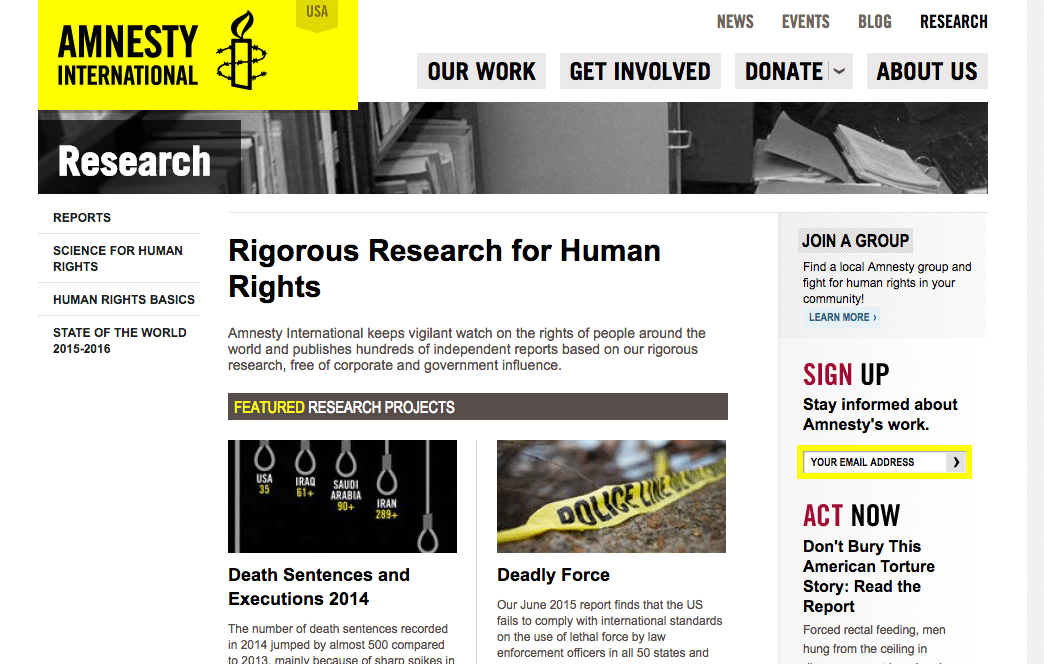
8. Use quality, effective images.
Your nonprofit story defines your organization, and images are a great way to share that story. Use impactful images that showcase your work, including your website, emails, and social media. According to Kissmetrics, photos get 53% more likes, 104% more comments and 84% more click-throughs on links than text-based posts.
The most effective way to use images is to focus on ones that feature people and places that are influenced by your work. Noteworthy (and shareable) pictures are usually:
- People, particularly faces turned toward the camera
- Not stock photos, but ones taken by your nonprofit
- Large with high resolution
- Optimized for mobile
Check out this UNICEF Facebook post, which includes one of thousands of great, compelling pictures meant to educate, inspire, and get the audience to act.
9. Be trendy.
Capitalize on current events and holidays. When something is trending, people want to be involved—and this includes your supporters. If there’s a way that you can connect your nonprofit to a current event, then do it online.
Keep in mind that a good portion of giving occurs during the last two months of the year. In fact, 31% of all giving occurs in December and 12% happens in the last three days of the year.
To stay relevant, try doing an online year-end or #GivingTuesday fundraising campaign to stay top of mind for those looking to give during the holiday season.
10. Create a recurring giving campaign.
People want to support causes they come across online, but there are times when a donor can’t make a one-time gift. It may be because their budget doesn’t match their desired giving amount or because they’d like to spread payments over the course of the year. Therefore, it’s in everyone’s best interest for organizations to create a recurring giving program.
Nonprofits benefit from recurring giving because this method keeps donors involved and engaged while also ensuring a steady flow of income for the organization.
One of the best recurring giving programs out there was developed by Watsi. This nonprofit sends a monthly, personalized message and thank you featuring a client helped with the donation, and they’ve seen amazing results because of this donation feature.
O
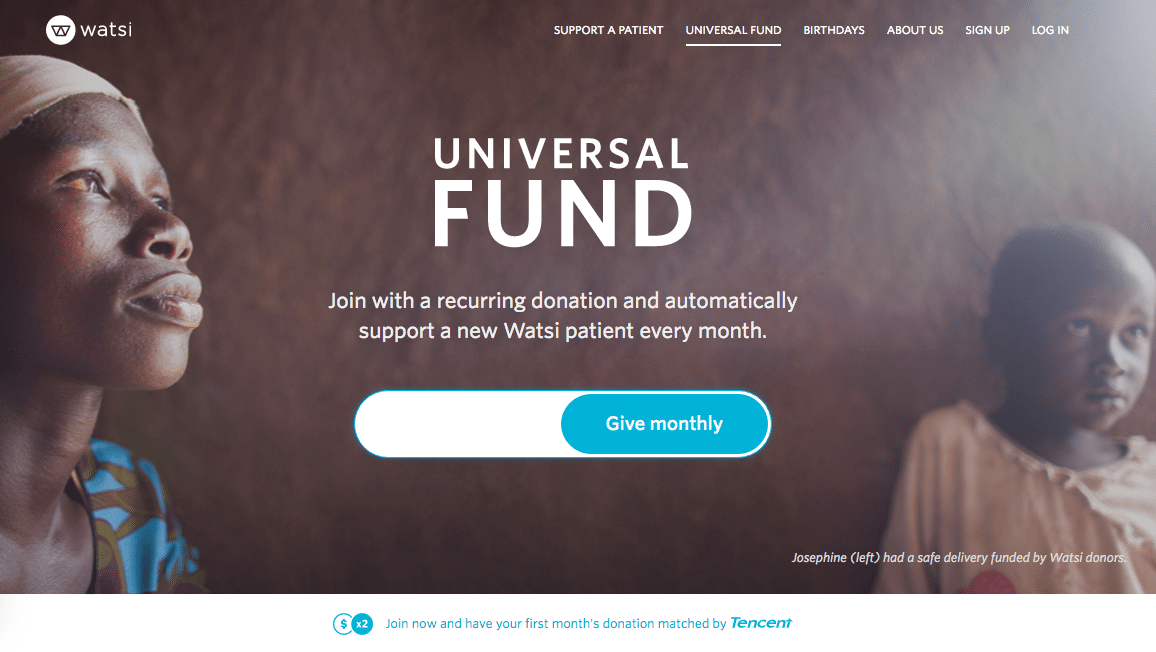
11. Recognize your supporters quickly and often.
After observing thousands of campaigns, we’ve found that thanking donors is the single most important thing a nonprofit can do to retain a donor. It’s easy to thank a donor when they’ve given in person, but what about those donating online?
If possible, send a personal email or make a phone call to acknowledge the gift. If you know your donor is comfortable with it (they chose to not give anonymously), give them a shout out on social media. The more you recognize their efforts, the more they’ll feel like an essential part of the cause. You can use marketing automation to trigger an email when someone makes a donation so the right message is sent to the right person at exactly the right time.
Research shows that attracting a new customer is 5x more expensive than keeping an existing one. With this in mind, St. Jude’s Hospital tracks when their donors last made a contribution and automatically sends a re-engagement email exactly three months after that date.
12. Keep donors (& prospects) updated.
You can keep donations coming in the door by communicating with your donors and prospects, not just about the status of the campaign, but of the impact of their gifts.
Send email updates and create/update your blog and website with the latest on your campaigns and work. If you calculate the return on investment, then definitely share that as well.
World Bicycle Relief allows supporters share status updates and results with supporters on their online fundraising website. This is a great way to keep everyone in the loop.

13. Use compelling storytelling to drive your cause.
Have you ever heard the concept of personal, not personalized, when it comes to upgrading your nonprofit donors? The idea is to make donors feel special and tug on their heartstrings—which means automation and bland, generic email blasts need to be thrown out the window.
Stories are a great way to create powerful connections with your audience. To do this effectively, you’ll need to give people the following:
- Statistics: Facts and figures give people a clear picture of the severity of the problem you’re trying to solve.
- Experiences: Sometimes the big picture doesn’t drive donations as much as an individual’s story. For instance, citing the fact that 1000 children need food may not tug at the heart. However, telling the story of the struggles that John—one of the children—goes through just to get one less-than-decent meal a week puts the situation in perspective.
Here’s an example of good storytelling in an email:
Source: Campaign Monitor
Using storytelling allows your audience to “live” the experience that your cause is going through, therefore appealing to their empathetic side. For nonprofits, empathy is one of the biggest emotions to trigger, as it helps loosen people’s purse strings.
So go ahead and incorporate storytelling in your quest to collect donations online.
14. Employ QR codes.
are powerful yet underutilized. QR codes, short for “quick response” codes, are technology that allows creators to store data in square-shaped black-and-white symbols. Users can then scan and read the data with the use of their smartphones. Scanning the code usually takes you to a website or some other online asset—in this case, probably a fundraising page or your donation forms.
To pull this off, you’ll have to design a compelling print ad that you can place in an area with either a lot of foot traffic or in direct mail publications that are widely read. You can also utilize your QR code on merchandise, event invitations, postcard mailers, and more.
Of course, you’ll have to use a compelling image, ad copy, and CTA to get people to get to stop and scan your QR code.
Source: Kindful
15. Offer alternative payment options.
One of the biggest advantages of collecting donations online is the fact that you can get support from all over the world. However, that also comes with its own complications—namely, the fact that your donors may have different payment avenues.
Getting around this is possible if you provide alternative payment options instead of only using those favored in your region.
Source: Donorbox
Wrap up
Sometimes it seems impossible for our nonprofits to keep up with the ever-evolving, demanding world of technology. But it’s coming, whether we like it or not.
Although your nonprofit may still get a bulk of your donations from offline sources, the tide is shifting. Incorporate these 15 techniques, and you’ll begin to drive more donations online and hopefully gain, educate, and engage donors in the process.
Need more tips on how to help your brick-and-mortar nonprofit garner more support for your causes? Then check out our ultimate guide to email marketing for nonprofits.

